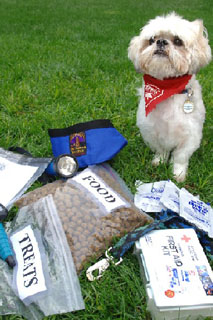
A Chihuahua lay dying in the arms of its owners……………………….
Recently Delaware boutique owner Liza Orlando finished work for the day and got ready to take a walk with her husband and two small dogs.
As they exited the shop their 4 year old Chihuahua, Fabio, ran outside and started barking at a larger dog that was passing by.
A dog fight ensued and Fabio was severely injured.
When the couple managed to get Fabio away from the bigger dog, he lay on his side, motionless and bleeding, but still alive. Fabio’s owners knew they needed to find a veterinarian ASAP.
As her husband frantically called 911 to locate the nearest emergency vet clinic, Orlando tended to Fabio, stemming the flow of blood from his wound and getting him ready to go to the vet. Orlando’s husband located a nearby veterinary hospital that offered 24-hour on-call care, they quickly made their way to the car and headed for the hospital.
But not all was working out the way it should.
24-hour on-call care usually means that there is a veterinarian on call 24-hours a day, but is not necessarily in the hospital.
And that’s what the Orlando’s discovered when they arrived at the veterinary hospital. The doors were locked and no one was there. There was, however, a number they could call for emergencies.
They called.
The only connection they could make was to the hospital’s answering service but not to a veterinarian.
Frustrated and panicked and they raced to a local human emergency room to see what help they could get for their dog. One of the nurses there gave them a warm blanket for Fabio in case he was suffering from shock. Someone from the human hospital then called the veterinary hospital and this time got the answering service to get the on-call vet on the phone.
The Orlando’s were relieved to reach the hospital’s vet until they learned that the on-call vet was at least 30 minutes away and was only on call for emergencies for EXISTING CLIENTS.
Despite Mr. Orlando offering to pay triple the veterinarian fees to get their dog help, the veterinarian would not see them at all because they weren’t clients, instead referring them to another emergency hospital in a nearby town, another hour away.
The Orlandos quickly left to get their dog help at the new veterinary hospital.
But Fabio didn’t make it to the next hospital. He died enroute in Mrs. Orlando’s arms.
THE AFTERMATH
The Orlandos say they are “absolutely disgusted” with the doctors and practices at the veterinary hospital and have filed complaints with every agency and newspaper in their area.
“Did not being a patient make Fabio less deserving of treatment as he was dying in my arms? These doctors are not animal lovers and they certainly aren’t veterinarians,” she said. “They are running some kind of exclusive members-only club. It’s repulsive to find that they allowed this to happen. Our Fabio would have been saved if they had not refused him treatment.”
The veterinary hospital says they don’t have enough manpower to maintain a 24-hour practice and feel they did their job by referring the Orlando’s to the closest 24-hour facility.
They don’t feel they did anything wrong.
“Any doctor who refuses treatment to an animal, or human, for that matter should be severely punished,” Orlando said. “The last thing this country needs is soulless businessmen and women masquerading as animal lovers.”
And the head of a local pet organization stated that she believes veterinarians should be forced to take a similar oath as doctors, which would require them to help pets in distress.
“It’s outrageous to make a grieving pet owner drive an hour to get emergency care for their animal,” she said. “The DVMA should be policing their own licensed veterinarians.”

How do you feel about this? Do you think the veterinarian should have been REQUIRED to treat Fabio or do you feel the Orlando’s should have confirmed the emergency vet status before taking their dog to the closed hospital?

 Tonight our community is having a holiday tree lighting ceremony and downtown stroll. I’m bringing my dog with me.
Tonight our community is having a holiday tree lighting ceremony and downtown stroll. I’m bringing my dog with me.
